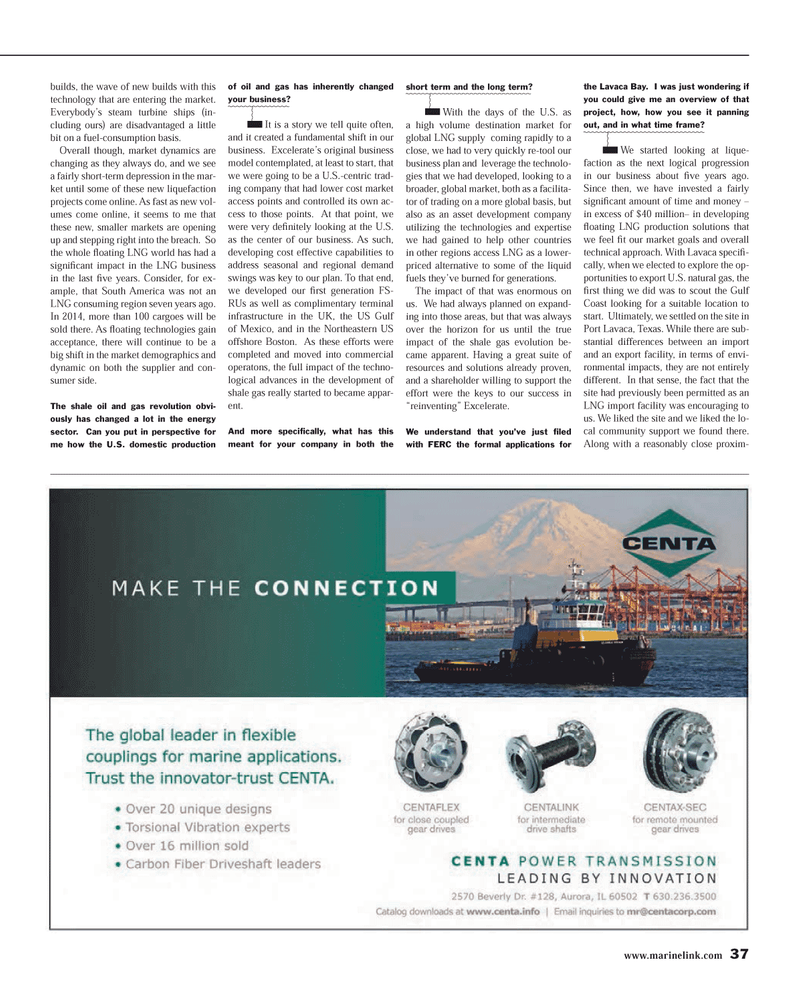
Page 37: of Maritime Reporter Magazine (June 2014)
Annual World Yearbook
Read this page in Pdf, Flash or Html5 edition of June 2014 Maritime Reporter Magazine
www.marinelink.com 37 builds, the wave of new builds with this technology that are entering the market.
Everybody’s steam turbine ships (in- cluding ours) are disadvantaged a little bit on a fuel-consumption basis.
Overall though, market dynamics are changing as they always do, and we see a fairly short-term depression in the mar- ket until some of these new liquefaction projects come online. As fast as new vol- umes come online, it seems to me that these new, smaller markets are opening up and stepping right into the breach. So the whole ? oating LNG world has had a signi? cant impact in the LNG business in the last ? ve years. Consider, for ex- ample, that South America was not an
LNG consuming region seven years ago.
In 2014, more than 100 cargoes will be sold there. As ? oating technologies gain acceptance, there will continue to be a big shift in the market demographics and dynamic on both the supplier and con- sumer side.
The shale oil and gas revolution obvi- ously has changed a lot in the energy sector. Can you put in perspective for me how the U.S. domestic production of oil and gas has inherently changed your business? It is a story we tell quite often, and it created a fundamental shift in our business. Excelerate’s original business model contemplated, at least to start, that we were going to be a U.S.-centric trad- ing company that had lower cost market access points and controlled its own ac- cess to those points. At that point, we were very de? nitely looking at the U.S. as the center of our business. As such, developing cost effective capabilities to address seasonal and regional demand swings was key to our plan. To that end, we developed our ? rst generation FS-
RUs as well as complimentary terminal infrastructure in the UK, the US Gulf of Mexico, and in the Northeastern US offshore Boston. As these efforts were completed and moved into commercial operatons, the full impact of the techno- logical advances in the development of shale gas really started to became appar- ent.
And more specifi cally, what has this meant for your company in both the short term and the long term? With the days of the U.S. as a high volume destination market for global LNG supply coming rapidly to a close, we had to very quickly re-tool our business plan and leverage the technolo- gies that we had developed, looking to a broader, global market, both as a facilita- tor of trading on a more global basis, but also as an asset development company utilizing the technologies and expertise we had gained to help other countries in other regions access LNG as a lower- priced alternative to some of the liquid fuels they’ve burned for generations.
The impact of that was enormous on us. We had always planned on expand- ing into those areas, but that was always over the horizon for us until the true impact of the shale gas evolution be- came apparent. Having a great suite of resources and solutions already proven, and a shareholder willing to support the effort were the keys to our success in “reinventing” Excelerate.
We understand that you’ve just fi led with FERC the formal applications for the Lavaca Bay. I was just wondering if you could give me an overview of that project, how, how you see it panning out, and in what time frame? We started looking at lique- faction as the next logical progression in our business about ? ve years ago.
Since then, we have invested a fairly signi? cant amount of time and money – in excess of $40 million– in developing ? oating LNG production solutions that we feel ? t our market goals and overall technical approach. With Lavaca speci? - cally, when we elected to explore the op- portunities to export U.S. natural gas, the ? rst thing we did was to scout the Gulf
Coast looking for a suitable location to start. Ultimately, we settled on the site in
Port Lavaca, Texas. While there are sub- stantial differences between an import and an export facility, in terms of envi- ronmental impacts, they are not entirely different. In that sense, the fact that the site had previously been permitted as an
LNG import facility was encouraging to us. We liked the site and we liked the lo- cal community support we found there.
Along with a reasonably close proxim-
MR #6 (34-39).indd 37 5/30/2014 9:18:42 AM

 36
36

 38
38
